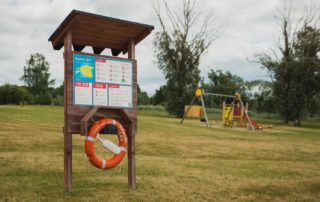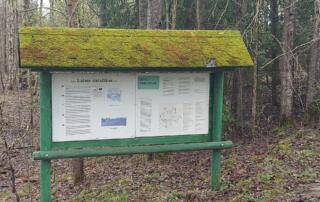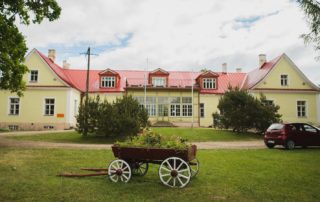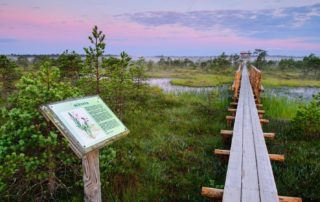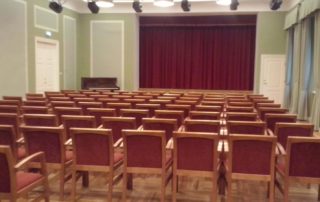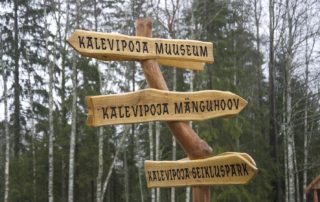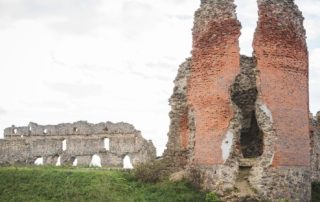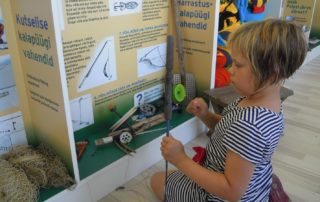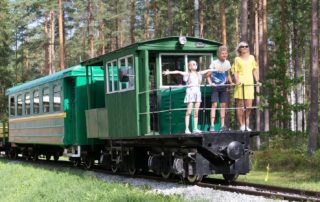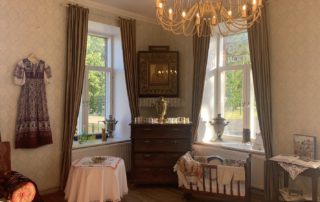Lake Kamari recreation area
Lake Kamari recreation area has become an extremely popular destination among holiday-makers for its beautiful views and forests. There are two jetties, areas for beach volleyball and football, a shower and toilets, benches and a playground for small children with swings and a slide. The swimming area is marked by buoys and there is also a children's pool.
Sacrificial spring ‘Laiuse siniallikas’
There is a mystic spring on the Laiuse drumlin. The spring was used as a sacrificial spring during the second millennium and considered a holy place by ancient Estonians. The folk believed that the spring is a source of strength, gives rain and drought, causes dearth or ensures a good harvest. They believed the water in the spring heals eyes and many other ailments. That is why the people respected their spring and made sacrifices to it.There is a nice boardwalk to the spring and a bench where you can admire the spring and think beautiful thoughts. Why not wash [...]
Võisiku manor
Võisiku manor was first mentioned in 1558. It was one of the biggest manors in Livonia in the 18th and 19th centuries, stretching from Põltsamaa to Lake Võrtsjärv. There were 52 buildings on the manor originally, some of which we can still see today, and a further 67 in outlying parts of the manor and its mirror factory. Lord of the manor Timotheus Eberhard von Bock, who drew up Russia's first constitution for Emperor Alexander I and was sent to the Schlüsselburg fortress for 9 years for doing so, is the central character in Estonian author Jaan Kross' novel "The [...]
Männikjärv hiking trail
Männikjärv hiking trail offers wonderful views of Lake Männikjärv and the bog surrounding it. The hiking trail enables you to walk through a boreo-nemoral forest; the 2.2 km trail is suitable for a beginner. The trail is marked with red signs on trees, and it takes about 1 hour to complete it. Good to know: - During high water, parts of the bog are impassable. - For staying at Männikjärv, organising a public event for more than 20 people and driving an all-terrain vehicle, you must first apply for a permit from the manager of the protected area – Estonian Environmental [...]
Pajusi manor
Pajusi manor was constructed in the 17th century. Its long, stone main building in Classicist style is thought to have been erected in the early 19th century. It was one-storey; only the central section was adorned with a small upper floor, which bears a distinct decorative window. In addition to the main building, the manor as a whole includes a number of other buildings and a large park. Did you know...? *Remaining of the main building of the manor are its central part and right-hand wing, which is home to Pajusi Community Centre
Kalevipoeg’s Home
Kalevipoeg's Home consists of the Kalevipoeg Museum, Kalevipoeg's Adventure Park, Kalevipoeg's Playground, and Saare Community Centre. The Kalevipoeg Museum provides an excellent overview of the Estonian national epic "Kalevipoeg". In the Kalevipoeg's Adventure Park, you can choose between lower or higher adventure trails and challenge yourself between the ground and the sky. Those who wish can also play discgolf. Kalevipoeg's Playground is a large fenced area, where you can find tools in the size fit for Kalevipoeg. Birthdays can also be celebrated here. Events can be organised in the Community Centre. The large hall can seat up to 100 people, [...]
Laiuse fortress ruins
Construction of the Laiuse fortress was launched by the Livonian Order in the late 14th century to defend its eastern borders. The first defensive structure in Estonia to be fitted with firearms, it gained its definitive appearance in the late Middle Ages. Cannon towers were added to the fortress in the mid-15th century. The fortress crumbled in 1559 but was restored, with wooden barracks built at the end of the Swedish era, which accommodated Karl XII and his entourage from 1700–1701. After the Great Northern War the fortress lay in ruins.
Permanent exhibition “Lake Peipus Living Room”
Lake Peipus Living Room is a permanent exhibition that gives visitors information about the natural conditions in Lake Peipus and the lives of people living by the lake. You can see models of the 34 species of fish that inhabit Lake Peipus. There is also a three-dimensional model of the lake that is 4 m long and 1.4 m wide and also shows the location of the towns and villages, accommodation establishments, museums, watchtowers and other places of interest near the lake. The Mustvee beach by Lake Peipus is marked with a yellow National Geographic window; it is one of [...]
Avinurme museum train
A narrow-gauge Sonda-Mustvee railway passed through Avinurme during 1926–1972. It was a true 50-year-long prosperity era for the villages located near the route. Today, a section of 178.5 metres of the former railway, the rail brigde, and the rail vehicle have been restored. All those who are interested are welcomed to take a nostalgic train ride from May to October, meaning the railway is opened when the weather is warm enough and the door of the locomotive can be opened and the railway is closed when the door of the locomotive freezes shut.
Exhibition “Samovars and Old Believers”
The exhibition's collection contains more than 50 samovars from various eras, countries, with different shapes and heating methods. The oldest samovar dates back to 1810. Samovars are accompanied by a multitude of tea glass holders (more than a hundred pieces). Photos of Russian Old Believers illustrate the walls. The exhibition also contains traditional items of the Old Believers, such as tea time and everything it entails, clothing, furniture, church equipment, icons, iconostasis, lampada, lestovkas, podrusniks, etc. You can also buy souvenirs, handicrafts and novelty products by the brand Varvara Gourmet.

